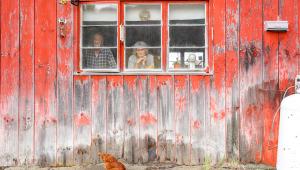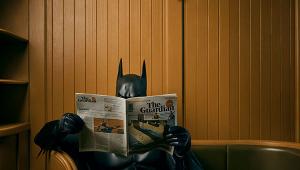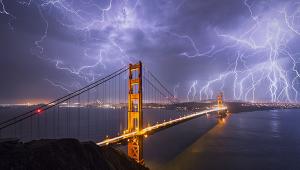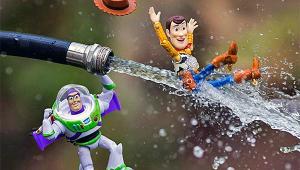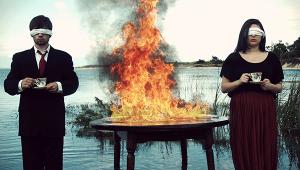Pro's Choice: Brian Bailey Enjoys The Challenge: “Whatever It Takes” Could Be His Motto
“I don’t have a favorite location. I just like the challenge of where I go and what I’m presented with on any given assignment,” advertising photographer Brian Bailey declares. One assignment lasting 10 days took Bailey to the Galapagos Islands, for a sunglasses company. But many assignments involve anything but sun-drenched conditions. In fact, the road to this point was a rocky one—of sorts…
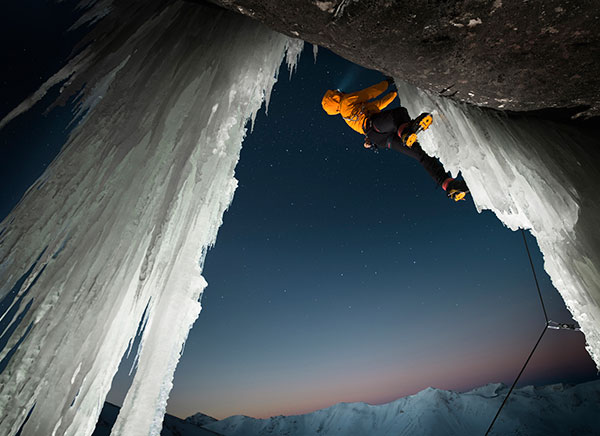
“One of the most inviting aspects of this assignment is that I was given carte blanche on how I’d execute each of the 25 shots I had to do. Usually, the client and agency would be there, but not in this instance: I had to move at a moment’s notice, when conditions were just right.” Brian Bailey shot this at dawn, in Redstone, Colorado, with a Hasselblad, 35mm lens, and Phase One back, lighting with two Profoto 7b’s on stands planted in ice and snow—the key light down at camera left, another head on camera right farther away. “We had to hike through the snow to reach a ledge from which we could gain this viewpoint from 30 feet underneath the overhanging ice bridge.” (Art Director: Karen Cathel; Agency: Doner.)
All Photos © Brian Bailey
Rock Climber To Photographer
“I was a rock climbing enthusiast in the mid-80s. I spent a couple of summers living in my VW bus in Yosemite and just stumbled on to photography and started photographing rock climbing. One thing led to another.” That set the stage. “I still do a little rock climbing, when an assignment calls for it.”
Based in Aspen, Colorado, Bailey specializes in action, people, and lifestyle. He started with Nikon gear but switched to Canon some years later and became a firm Canon user when he went digital. While he owns most of the equipment he uses, which includes a Canon EOS 5D-series body, Bailey will rent a Canon EOS-1D X for available light shoots requiring fast bursts.
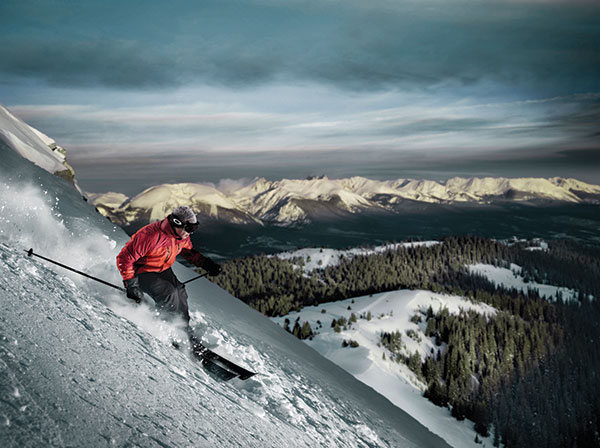
Working to a layout and shooting at dawn, Bailey used a Hasselblad and what he calls “scissor lighting,” with two lights hitting the skier from left and right as he’s moving through the shot. “We got there on a snowcat at about 4am and hiked down to this spot. For each take, he had to hike back up this steep slope, so we only did a handful of takes.” The shot was later composited to blend the contrasting background and foreground exposures. (Art Director: Rich Rodgers; Agency: Cultivator.)
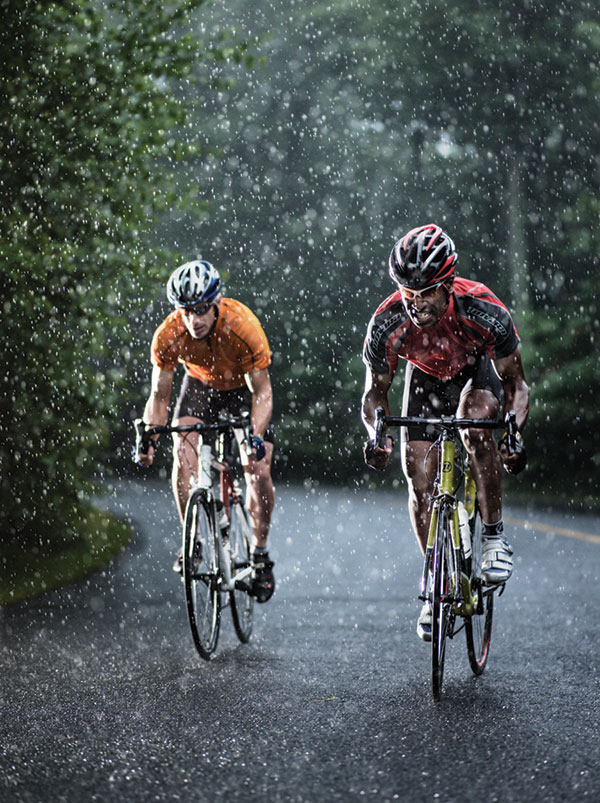
The shoot was scheduled in a state park outside Boston and everything was in place when the downpour hit. There was no turning back at this point. Bailey simply adapted to the situation, reworking the layout, which did not call for rain. “My assistant grabbed an umbrella and held it over my head.” Shooting with a tripod-mounted Hasselblad, Bailey employed his scissor lighting to ensure the riders would be properly lit. (Art Director: Chris Mahan.)
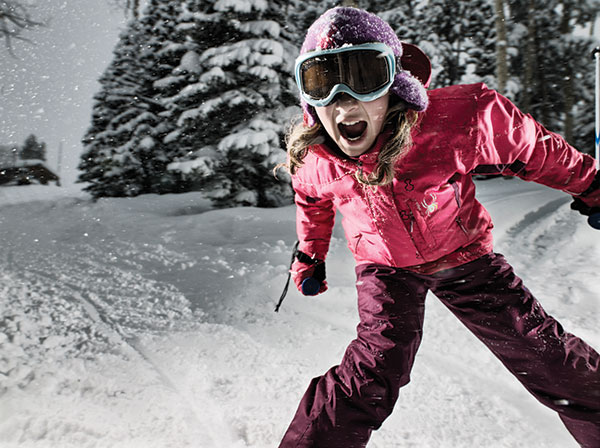
“It was overcast and snowing, so I’d decided to light the scene to make it more dramatic.” Bailey had this idea for a really in-your-face type of shot that suggested high energy and enthusiasm. “She flew past the camera, brushing me as she went by.” He used two Profoto 7b’s, one farther back to the left, the other on the right, shooting with a Hasselblad. “Much of the timing is instinctual. But I also have my assistant give me a mark, taking into account the shutter delay.” This was shot in Aspen, Colorado.
Medium Format Choice
The D-SLR, however, is not his mainstay camera. Bailey takes a Hasselblad with a Phase One IQ140 back on most shoots, even on the slopes. He values the higher sync speeds that the Hasselblad can deliver and for one very good reason: Bailey shoots many of his outdoor assignments with studio strobe, practically disregarding the terrain. “I’m very meticulous about sharpness, because I guarantee that at 1/250 second, you’ll get motion blur when a skier is coming at you. Also, I see things differently using medium format. More to the point, it’s just comfortable for me.” The lenses he favors for his Hasselblads include 35mm, 50mm, and 80mm. With the Canon, he tends to favor the wider focal lengths—such as 16-35mm. “The 70-200 f/2.8 IS is a workhorse, but not my go-to lens.”
He most often shoots with the camera tethered to a Mac. But he’ll also furnish the client and art director with iPads so they can get a live view of the shoot when the situation proves too precarious for them. And much of his work involves the camera on a Gitzo tripod with a Bogen pan-and-tilt head, especially for the medium format, for the simple reason that this allows him to lock down the camera should he later need to composite the shot when foreground/subject and background exposures don’t mesh in a single frame.

“Having closed off the road to traffic in this Aspen, Colorado, location (after obtaining the required permits), I stood squarely, waiting for the riders with my tripod-mounted Hasselblad. At a signal from my assistant, I took the shot and just as quickly ran out of the way.” Bailey employed one raw strobe head (sans light shaper) at camera right, retaking the shot at least 10 times. (Creative Director: Kyle Taylor; Art Director: Eric Thompson; Agency: VML.)
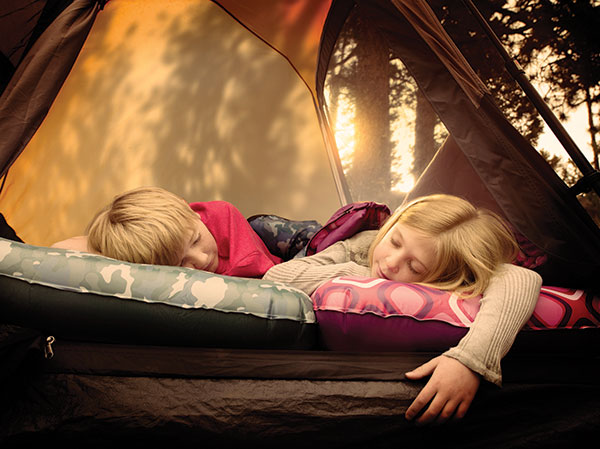
“I wanted to convey the magical moment shared on a family camping trip.” And what better way to say “family” than to hire talent who were actual siblings! The shot is designed to convey the feeling of exhaustion after a fun day outdoors, with the children sleeping on the featured product—an inflatable air mattress. “We wanted to get a low angle and do something a little different, shooting outdoors on location, instead of inside the studio. My Hasselblad is on the ground on a tripod, as low as I could get.” Bailey lit this shot with an Elinchrom Octabank. (Art Director: Kelly Anderson.)

Featured is 2014 Olympic gold medalist Mikaela Shiffrin (photographed before the Olympics). Bailey had to photograph her in numerous situations, from the slopes to the kitchen, starting early in the day—and concluding with this shot, all following her very strict training schedule. “By the time we arrived at this location a short distance from her home, there was no sunlight left. Shooting with a Hasselblad and 80mm lens, we set up a beauty dish with a grid behind her, slightly to camera left, and an Octabank to camera right, within a few feet of her.” (Creative Director: Sonja Olson; Art Director: Brett Zerr; Agency: TPN.)
Studio Strobe…In The Snow
“I have to own a fair amount of lighting equipment where I live, because I don’t have ready access to rental houses.” Bailey lights almost exclusively with Profoto Pro-7b on location. “I usually take at least three 7b packs and heads on outdoor assignments.” When the job requires him to be in the studio, he turns to the Pro-7a.
To shape the light, Bailey prefers an Elinchrom 6-foot Octabank, but also uses a Profoto beauty dish with a grid and Chimera strip lights. He will also employ 8x8-foot silks for the middle of the day, set into a Matthews frame or a Scrim Jim.
Getting Around
Bailey hires a location scout to recommend locations he may not be familiar with, but he always arrives a day or two early with his assistant to tech-scout the area. While he flies outside the state, in Colorado he drives his minivan to a shoot site. Hauling equipment from the vehicle, when distances exceed 100 yards on foot, often involves Lowepro backpacks for both camera and lighting gear. Otherwise, he’ll stow gear in hard cases.
“I’m a snowboarder, so that’s how I get around in snow country. When we’re doing any ski-related shoot, my assistant and I are on snowboards and skis, respectively, but we also use snowcats. Usually the ‘cat’ will take us up to where we set up our base camp, and we ski or snowboard from there. Sometimes the cat delivers us to the shoot site directly.” Depending on budget and location, Bailey will work with one or more assistants, adding a digital tech where possible to handle the files.
“My crew and I think nothing of carrying lots of gear on assignment, regardless of the conditions. In blinding snow, we’re tethering to the laptop, lighting with Profotos. We face the challenges as they come along. These adverse conditions keep the adrenaline flowing from one shoot to the next and stimulate us to do our best.” In fact, “people always talk about the energy in my work.”
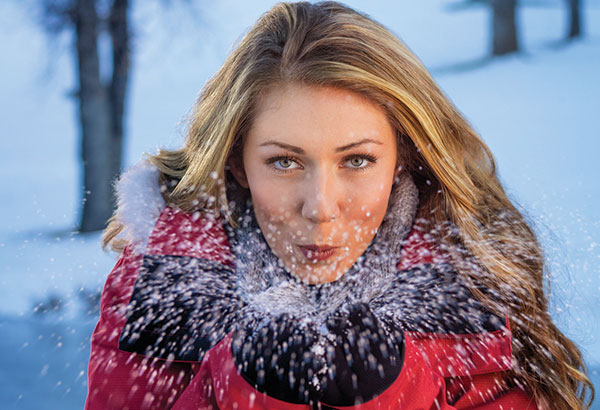
Pharmaceutical companies often prefer to feature actual people who use their products, as in this case. Bailey worked to a layout, shooting in the San Francisco Bay area. “We rented an airplane because we’d wanted to get the look of this person flying in to a remote location. The layout didn’t call for a dog but we improvised when the pilot showed up with the dog the day we were tech-scouting.” Lighting involved one Elinchrom Octabank on camera right. “The tough part here was that we’d only be allowed to shoot this person during certain hours of the day, neither early or late, so we had to work with the afternoon sun, which in this case worked in our favor, adding a warm glow.” The shot was later composited from separate frames for the man and airplane, sky, and water. (Creative Director: Michele Monteforte; Art Director: Mel Ferrell; Agency: CDM Link 9.)
Most Challenging Assignments
When asked about his most challenging assignment, Bailey recalled one from some years back, when he was still shooting film. “My assistant and I were at the top of this climb. I had to send Polaroids down to the art director in a pouch, and we’d communicate via walkie-talkies.”
But a more recent assignment also came to mind, this one for Polartec. “We had to shoot a variety of rock climbing images. One shot involved what climbers call a ‘big wall.’ The challenge there was that I and my assistant had to rappel off the edge of what was at least a 1000-foot wall in Black Canyon National Park in Colorado to photograph other rock climbers 1000 feet off the ground. We had a Profoto 7b that my assistant held while he was hanging at that height. Coupled with that, we needed to communicate with the Art Director (AD), who couldn’t be expected to be hanging off ropes, and we couldn’t tether the camera to a laptop. So I had to send my memory cards up to the digital tech at the top, who stood by with a monitor to show the client and AD what we’re getting.”
To see more of Brian Bailey’s work, visit www.brianbaileyphotography.com.



